In the Italian, Italian-American, restaurant communities — and beyond — Lidia Bastianich is a true icon.
Another community she's a proud part of? The immigrant community.
Emblematic of the Italian-American experience and a matriarch of a "food family" that stretches across industry and time, Bastianich is a bastion of ingenuity and talent. She has had a hand in the growth and expansion of Italian and Italian-American food over the years and has also been one of the foremost women in restaurant kitchens, dating back to the 1970s.
To put it lightly, she's a legend.
About a decade ago, I met Lidia at a cookbook signing at a local grocery store grand opening (I was inexplicably wearing a messenger cap, but that's neither here nor there). She was warm and kind, we smiled and took a quick photo and I was on my way, but her generosity and openness was evident — and that same trait came through tenfold in this conversation, in which we spoke about Lidia's upcoming PBS special "Lidia Celebrates America: Flavors That Define Us."
We spoke about the ways immigration shaped her childhood, her favorite foods from her youth until now, the various chefs and personalities featured in the special and about the incredible importance of immigrants in our country, from a food capacity to a holistic one.
The following interview has been lightly edited for clarity and length.
The immigrant experience is something deeply important, personal and impactful — but it differs from person to person and each story is so layered and complex. Can you tell me about your immigration experiences as a child and how they impacted you, both personally and regarding food and cooking?
After the WWII ended, we were Italians who were caught behind in the newly formed communist Yugoslavia. Food was scarce. Most of what we ate was produced by my Grandma Rosa and Grandpa Giovanni. I was a young child and helped them to procure food for the family. I fed the chickens, the geese, milked the goats, foraged clover for the rabbits and helped with the butchering of the pigs. We also had a garden that produced most of the seasonal vegetables, legumes, potatoes and turnips, wheat, corn and fruits. I helped with harvesting, canning and drying them for the winter months. I grew up with the scent of good seasonal foods all around me; those memories are still with me today and I recall them when I am cooking now.
When I was 10 years old, in 1956 my parents decided that they did not want to raise us under the communist regime where, in addition to food being scarce, we were not allowed to speak Italian or practice our Catholic religion. So, they decided to escape over the wired border back into Italy. Being without legal papers, we were put in a refugee camp in Trieste, San Sabba.
There, I spent two of my formative years, which shaped my character because I came to understand and experience being without a home and also being away from the nurturing of grandma and grandpa. I began cooking ever more, working with the nuns in the school kitchen during recess, because food and its aromas brought me right back to the memories of that secure place with grandma.
When we were eventually approved to immigrate to the USA when I was 12, my life had been shaped dramatically by these events and memories and I carry those experiences with me today in everything that I do. I understand what it means to need help and the relief and satisfaction when people are helped. I understand the value of freedom and democracy, the freedom to speak one's language and the freedom of worship. What I understand ever more is the act of being grateful and giving back.
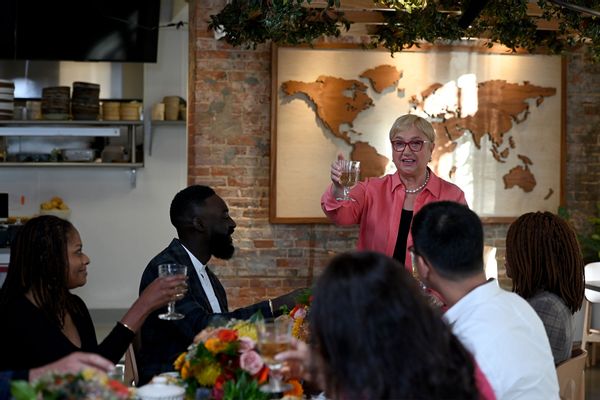 Lidia welcomes guests to the Final Dinner at Immigrant Food in downtown Washington, DC in "Lidia Celebrates America: Flavors That Define Us" (Meredith Nierman/GBH & Tavola Productions)
Lidia welcomes guests to the Final Dinner at Immigrant Food in downtown Washington, DC in "Lidia Celebrates America: Flavors That Define Us" (Meredith Nierman/GBH & Tavola Productions)
There's such a never-ending battle, if you will, between attempting to assimilate while also simultaneously holding steadfast to one's customs, cultures, languages and foods. Can you talk a bit about that balance?
I recall when I arrived in the USA at 12 years old, I felt out of place, insecure, not able to speak the language and didn't know anyone. I wanted to learn English as fast as I could and become an American as fast as I could, so that I could flourish in my new country. I understood and was grateful that America was now my home. As a child, after the insecurity of the escape and life in the refugee camp, I needed to be grounded; I needed a place that would be my home forever. So, I did everything I could to "become American." It wasn't until I had become more firmly established here that I began to re-assimilate some of my heritage into my new life. I think for any immigrant, it is a personal choice as to what to bring and what new things to embrace. But we should always be proud of where we came from and not be afraid to share our culture.
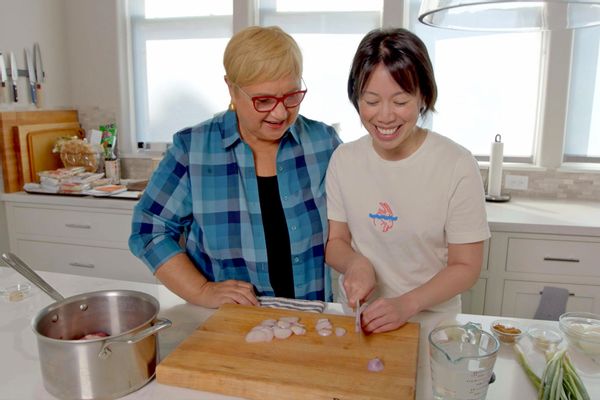 Lidia cooks with chef Christine Ha during a visit to her Houston home in "Lidia Celebrates America: Flavors That Define Us" (WGBH Educational Foundation and Tavola Productions)
Lidia cooks with chef Christine Ha during a visit to her Houston home in "Lidia Celebrates America: Flavors That Define Us" (WGBH Educational Foundation and Tavola Productions)
Christine Ha's story is incredible and inspiring — what lessons did you take away from that discussion?
I think Christine is an extraordinary and strong woman who is embracing life to the fullest. She has a strong desire to continue her connection to her Vietnamese roots, which is a sentiment connected to the loss of her mother at a young age. In that way, she stays connected by cooking the food her mother taught her. This is very much the same lesson that I learned through my journey: Food is a connection and a way to serve the legacy of others who came before us.
The Washington DC experience seemed terrific; what was it like to eat foods from so many incredible chefs all representing such dynamic, unique countries?
It was inspiring to see all those young chefs, now American, honoring their roots in the food they cook. I could taste their passion and flavors of their home in the foods they prepared.
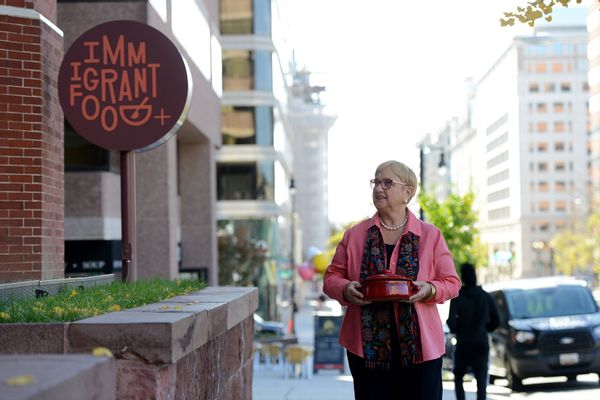 Lidia brought Escarole and White Bean Soup to this year's final dinner, held at Immigrant Food in downtown Washington, D.C. in "Lidia Celebrates America: Flavors That Define Us" (Meredith Nierman/GBH & Tavola Productions)
Lidia brought Escarole and White Bean Soup to this year's final dinner, held at Immigrant Food in downtown Washington, D.C. in "Lidia Celebrates America: Flavors That Define Us" (Meredith Nierman/GBH & Tavola Productions)
You brought escarole fagioli to that meal: Why is that dish special to you and your family?
This dish brings me right back to that comfort place of my youth. Even though the ingredients are poor, the flavors and memories of this dish are rich to me.
Want more great food writing and recipes? Subscribe to Salon Food's newsletter, The Bite.
What's something about Italian or Italian-American food that you think is misunderstood by some?
Italian-American food came from the early Italian immigrants who arrived in America but could not find their traditional ingredients — certain vegetables, cheeses, cured meats, etc. Instead, they made the recipes they loved and remembered, but with the new ingredients they found in America. On the other hand, the traditional Italian cuisine is all about the regional delicacies and seasonal products found around Italy, like prosciutto, aceto balsamico, bottarga and the like. While the final dishes are not the same between the cuisines, they are created in the same spirit: using seasonal ingredients and regional products that one has available to them, wherever they are located.
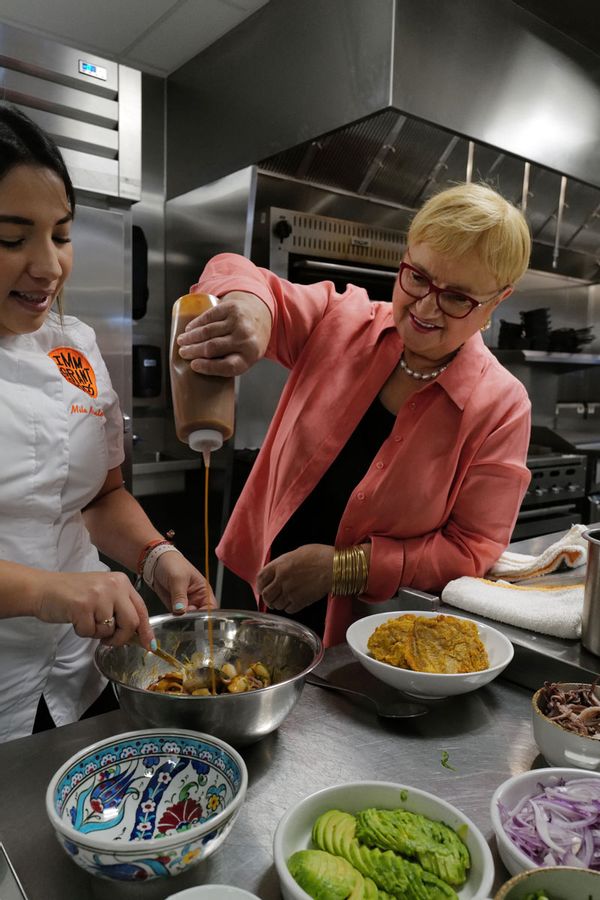 Lidia adds the special sauce to Mile Montezuma's Venzuelan ceviche at immigrant Food. Washington, D.C. in "Lidia Celebrates America: Flavors That Define Us" (Meredith Nierman/GBH & Tavola Productions)
Lidia adds the special sauce to Mile Montezuma's Venzuelan ceviche at immigrant Food. Washington, D.C. in "Lidia Celebrates America: Flavors That Define Us" (Meredith Nierman/GBH & Tavola Productions)
I don't eat red meat anymore, but when I did, I loved ropa vieja! In that segment, there's a lot of discussion about music in addition to cooking. What are some of the overlapping components between music and food, especially when it comes to honoring one's heritage?
Similar to food, music tells a story, reflects the customs of a culture, brings back cherished memories and binds people together by its beauty and the pleasure it gives them. People identify and bond under the sounds and words of their songs.
Were there any particular dishes, recipes or ingredients that you felt especially stood out amongst all of your illuminating discussions with so many diverse immigrant voices and experiences?
There were certainly many different flavors and new aromas encountered in meeting and cooking with all these great people. But the one element that truly touched me and made me feel part of their family/clan, was the way they gathered and shared their food . . . sitting on the floor, eating and collecting the food with my hands was liberating in a sense . . . I love touching food with my hands — raw or cooked.
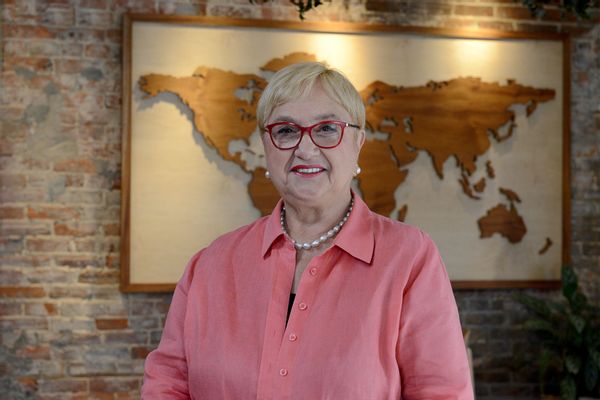 Lidia ready to welcome guests to Immigrant Food, Washington, D.C. in "Lidia Celebrates America: Flavors That Define Us" (Meredith Nierman/GBH & Tavola Productions)
Lidia ready to welcome guests to Immigrant Food, Washington, D.C. in "Lidia Celebrates America: Flavors That Define Us" (Meredith Nierman/GBH & Tavola Productions)
This is a tricky one, but as an Italian-American cook, I have to ask! If you had to pinpoint a singular favorite Italian or Italian-American dish, sweet or savory, what would it be?
One of my favorite Italian regional dishes is Linguini with white clam sauce. One of my favorite Italian-American foods is Chicken Parmigiana. To me, these represent the pinnacle of each cuisine!
Many of the people you spoke with in the special live in rural areas. What did you learn about the bridge between rural communities and immigrants in your work and travels?
What I discovered is that immigrants in rural communities became integrated into those communities faster than immigrants did in larger, more populated cities. Big cities present greater challenges than small towns in many ways, so immigrants in cities seem to create their own ethnical neighborhoods where there is emotional safety and familiarity in numbers. Creating these neighborhoods that sell food products that families are accustomed to or having worship practices that are "like back home," create a sense of safety and community. It appeared to me that in smaller towns, a helping hand is also extended more readily.
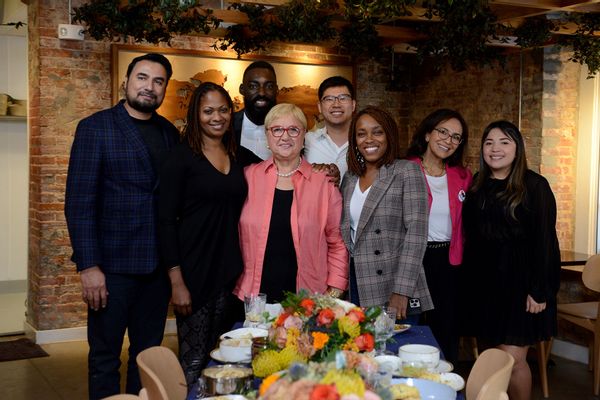 Lidia and final dinner guests gather for a photo after dinner at Immigrant Food, Washington, D.C. in "Lidia Celebrates America: Flavors That Define Us" (Meredith Nierman/GBH & Tavola Productions)
Lidia and final dinner guests gather for a photo after dinner at Immigrant Food, Washington, D.C. in "Lidia Celebrates America: Flavors That Define Us" (Meredith Nierman/GBH & Tavola Productions)
Is there anything else that we haven't touched on that stood out to you during filming or anything that's come up since regarding immigration which you think would be important to note?
It was particularly fascinating to see how each of these communities uniquely welcomed their new members. Not only how they first embraced them upon arrival, but then how these communities followed through in helping the new members secure their finances and giving them advice so that they would all become stronger as a community. This is one of the great attributes that America offers to all immigrants.
"Lidia Celebrates America: Flavors That Define Us" premieres Tuesday, May 30 at 9:00 pm ET on PBS stations (check local listings) and will also stream starting that day on PBS.org and the PBS App.


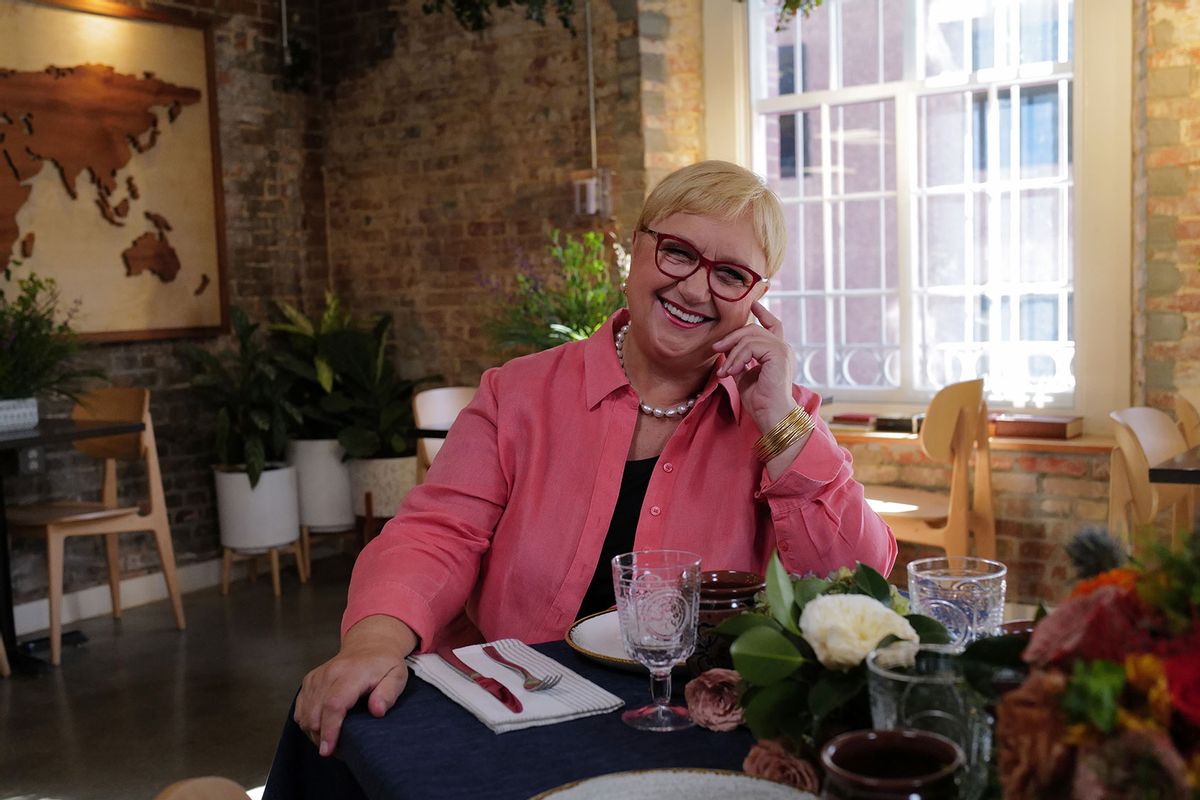
Shares